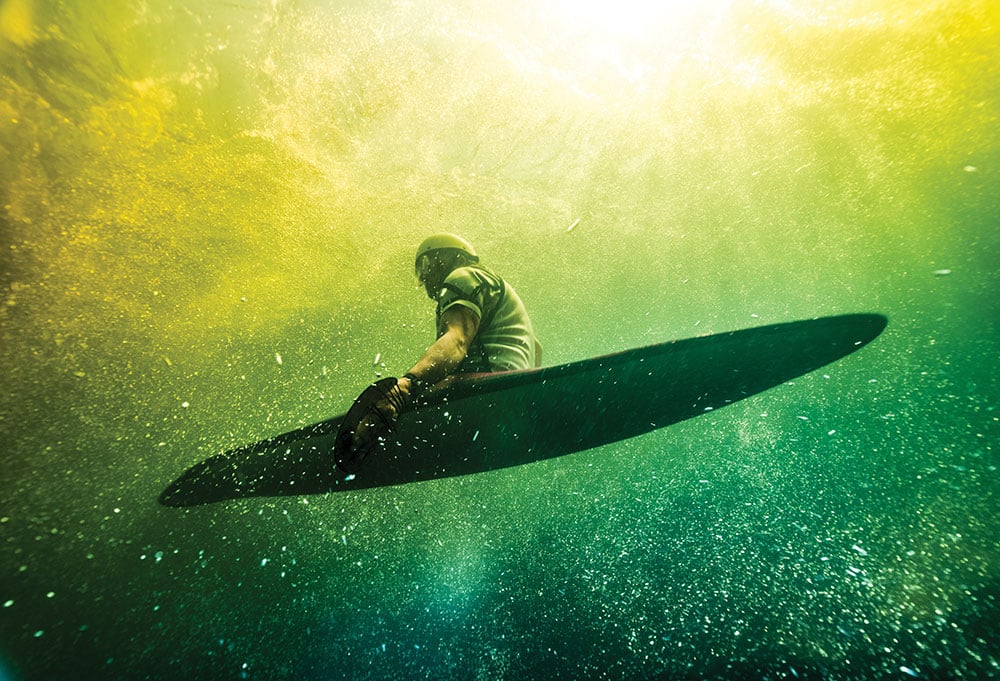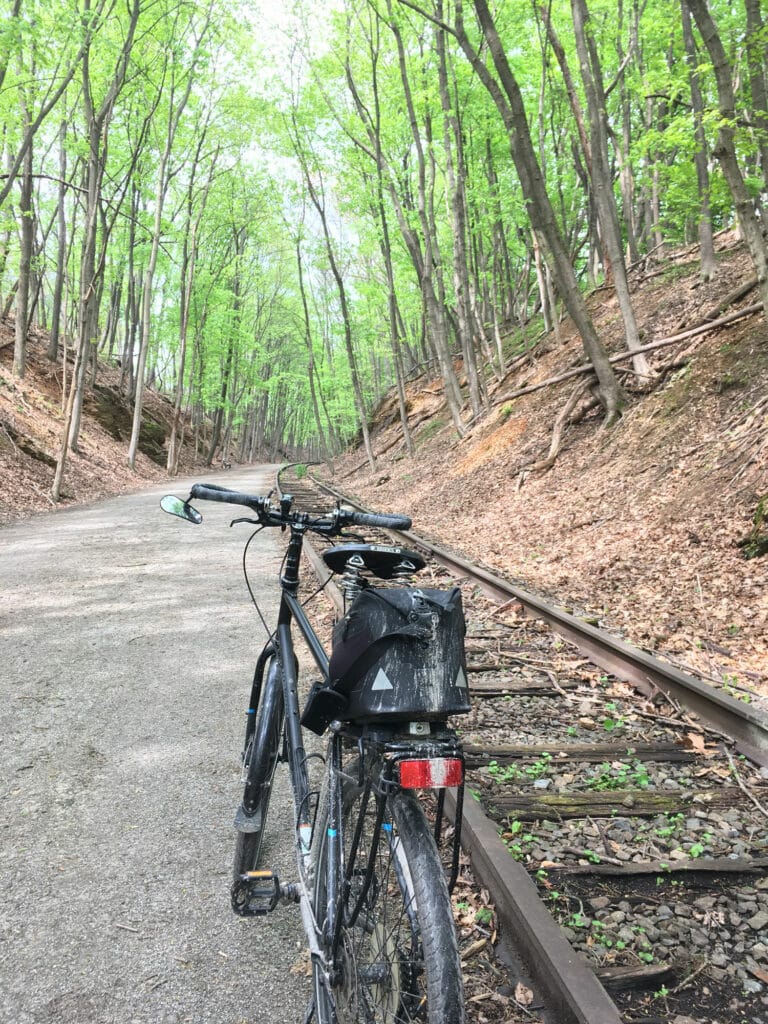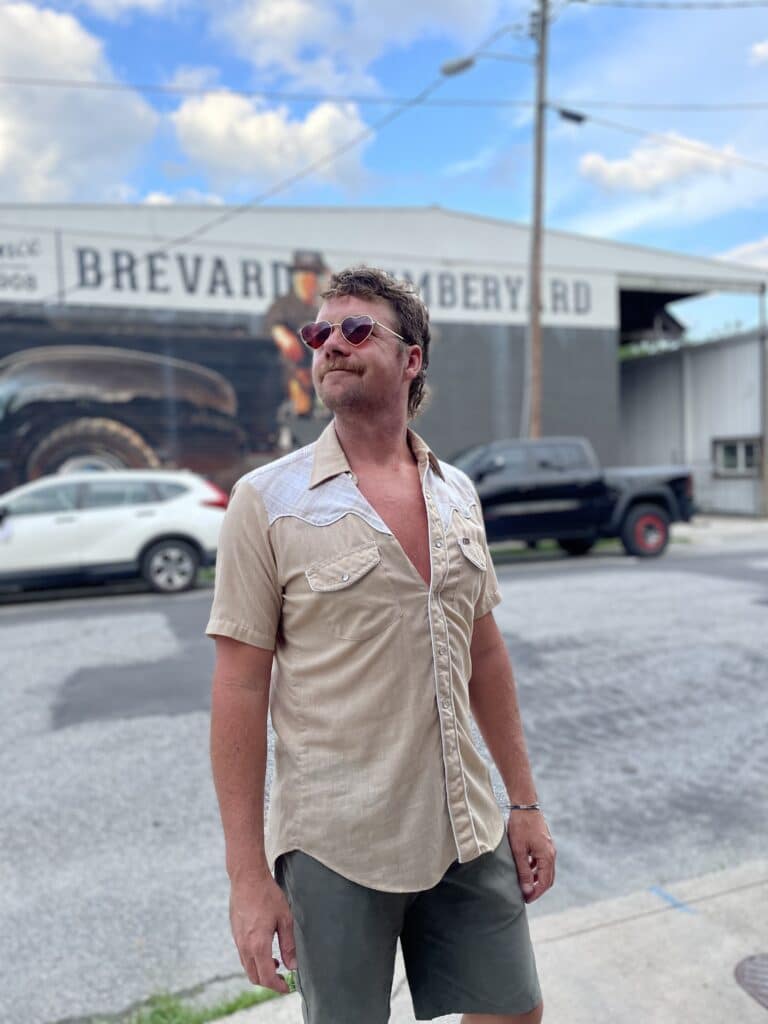Kayakers With Special Skills Slip into Squirt Boating
Often referred to as the grandfather of freestyle kayaking, squirt boating is a curious and beautiful sport where paddlers slip underwater to perform mystery moves and complete freestyle tricks on the surface. It’s a sport that requires focus, technique, and specialized boats that allow paddlers to submerge themselves in the river.
Risa Shimoda, an accomplished paddler and river advocate, compares squirt boating to the dance technique she learned growing up. “Learning how to squirt boat involves really understanding the water, yourself, and how you interact with it,” she said. “It’s very dance-like. Everything you do in dancing relies on you mastering what your feet and body are doing. Squirt boating is very much like that. Those who are good at it have incredible connection and mastery over the boat and the water around them and an awareness of their place in space.”
Shimoda, the first woman to run the Green River Narrows, represented the U.S. at nine Freestyle World Championships. She learned about squirt boating as it was arriving on the scene in the mid-80s.
“Like boating in general, those who share a certain type of interest in a certain type of boat or paddle a certain type of river become a little subculture of a subculture,” she said. “We got to know many of the squirt boaters at the time around the country who were in pockets where the rivers ran all year long.”
Squirt boating requires certain river conditions, like powerful eddies and deep waters, to initiate moves underwater. Around 300 spots in the world have been identified as ideal squirt boating locations, including Fascination Alley on the Cheat River in West Virginia.
“It’s truly a sport that’s not for everybody, and really not for most people,” said squirt boater Joel Wolpert. “That’s not an elitist thing at all. Most people when you talk about being stuck in a boat that’s uncomfortable, deep underwater, holding your breath is just not most people’s idea of fun.”
The Pioneers
Jim Snyder’s interest in paddling started at a young age, racing boats in his youth, working as a raft guide as a teen, and eventually apprenticing under a master paddle builder. In the early 80s, paddlers were building smaller boats to try new tricks on the water.
“In the early days, it was a way to define that you were an expert,” Snyder said. “You could do things with those boats that you couldn’t do with the old-fashioned boats. But now there’s a lot of different ways to be an expert.”
The niche discipline got its name from its early days when paddlers were testing the limits of how far they could push the boats underwater.
“It got the name from a friend of mine, Phil Coleman, from back when we would just sink one end of the boat or the other,” Snyder said. “You could do the bow or the stern, but not both. One day he sunk the stern, which is like doing a wheelie on a motorcycle. But then all that buoyancy that was trapped underwater meant the boat rushed back to the surface. So, it was like a bar of soap squirting out of your hand.”
As Snyder and others advanced the boat designs, paddlers discovered they could push themselves farther underwater with lighter boats. The mystery move was born as they found they could stay underwater for as long as they could hold their breath in the moving water. “Most of the time you’re like a leaf in a storm and you have no idea where you are,” Snyder said. “You’re just getting blown around. It’s a little scary. Sometimes you get pulled real deep or the water is really dark. You don’t fight with the river. Just kind of work with it and try to relax as much as possible. It’s a powerful and dynamic thing.”
Shimoda said the mystery move is all about finesse and technique, not strength.
“To initiate a mystery move, you really have to be focused on the angle of your boat and body,” she said. “You take advantage of the difference between the calm water and the moving water. You could watch somebody do a mystery move, try it a million times, and not be able to do it if the boat angle and the position of your body isn’t just so.”
Most squirt boaters use hand paddles to give themselves better control under the water. “If you have a paddle, you have all that surface area that wants to goof you up,” Shimoda said. “If you twist it a teeny tiny bit, it’ll pull you back up to the surface. To stay in control, if you have your paddles on your hands, you can manage everything close to your body.”
Underwater, paddlers don’t hear the comments, cheers, and claps from spectators on the riverbank.
“You’re kind of in a suspended state from a personal interaction standpoint,” Shimoda said. “It’s really like if you’re reading a technical paper and you absolutely have to turn the music off, get to a quiet space, you’re not eating lunch, and you’re focusing on the content.”
The World Champion
Before heading into the 2019 International Canoe Federation Freestyle World Championships, Rose Wall was just hoping to make it to the finals. She returned from Spain with a gold in women’s kayak squirt.
“I definitely was not expecting to do that well,” she said. “I spend a lot of time going squirt boating just for fun doing mystery moves. I’m pretty terrible at the freestyle aspect and I do not have the self-discipline to go out on flatwater and practice my freestyle moves.”
Squirt boating competitions are made up of two aspects: freestyle tricks on the surface and mystery moves underwater. Even though other boaters performed more technical freestyle tricks, Wall took home the win because of her longer mystery moves.
“When you do a mystery move, you get a certain number of points for every second you’re completely underwater,” Wall explained. “I had two different 17-second mystery moves in that ride. In addition to that, if you are able to get a mystery move in your ride, then the rest of your points for tricks are doubled.”
A friend introduced Wall to squirt boating back in college because she enjoyed paddling slicey kayaks. She found a used boat in her size, took it out a few times, and fell in love. Wall, an artist on the side, paints paddlers underwater to illustrate the sport that very few actually experience.
“One of my favorite parts about squirt boating is it’s just so breathtakingly beautiful underwater,” Wall said. “Just watching the sunlight filter through the different colors of the river water that you’re in, watching all of the bubbles, and seeing how the shadows move is really beautiful. Before there were people taking video of it, I would try to describe it to people and they would just not get it. Painting it was one way that I could express to people how beautiful it is underwater.”
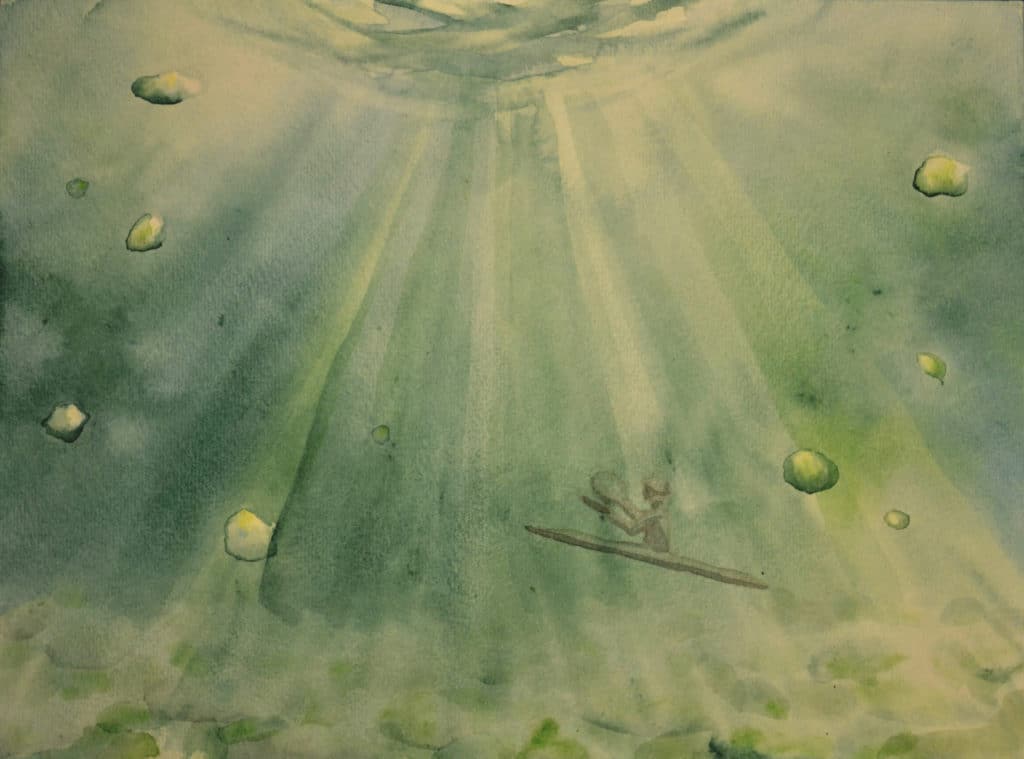
It’s a hard sport to get into because the boats are custom made for each paddler depending on their size and weight. Although it’s a small community, Wall said other paddlers helped her find boats and skirts close to her size when she was first starting out. “The really simplistic idea is maximizing your surface area and minimizing volume so that you can catch the downdrafts in the river and go underwater,” she said. “You’re really trying to get the perfect amount of volume for your weight and spread out the volume, so the buoyancy matches where your weight sits when you’re sitting in the boat. There’s just not that many women who do this sport, and so it’s pretty hard to find smaller boats.”
The Boat Builder
Building a squirt boat is something Joel Wolpert has thought about since he was a kid watching his uncle paddle. He was 10 years old the first time he got into a squirt boat.
“I’ve heard that oftentimes the passions that you develop as a kid are the ones that stick with you,” he said. “Because I was around paddling and I’ve always liked building things, I think that’s why I always come back around. It’s just another fun way to explore the world where you are.”
When Wolpert finally decided to try making his first boat last summer, Snyder gave him tips and advice from his own experience. To build a squirt boat, you first have to build a full-sized model of the kayak in order to cast a mold. The deck and hull are cast separately and then cut down to fit the paddler.
“You grind a little bit away from different sides to make it fit better and float better,” Wolpert said. “It’s kind of like fitting a dress. Coming out of the mold, it’s not going to fit your user perfectly. So, you got to tailor it.”
Throughout the process of building his first boat, The Spinster, Wolpert was already coming up with ideas for his next project. With The Idyller, his current project, he’s trying to create a snappier and more comfortable boat.
“To somebody who’s not familiar with squirt boats, they all kind of look the same,” Wolpert said. “Most all kayaks, you sit with your knees kind of splayed wide, so your hips are open. The smaller the boats are, the less comfortable that is, unless you have tremendous hip mobility. So, I thought I could kill two birds with one stone and make a boat where your legs are straightforward, so your hips aren’t open. And it would bring in the width of the boat. You’d have a lower wetted surface area, so it’d be super snappy underwater.”
It’s that part of building a boat, figuring out how to get the most out of the craft, that keeps Wolpert engaged. “Jimmy [Snyder] says squirt boating is a perfect waste of time,” he said. “And it totally is. It’s just so intriguing trying to figure out how to make things that work.”
The Photographer
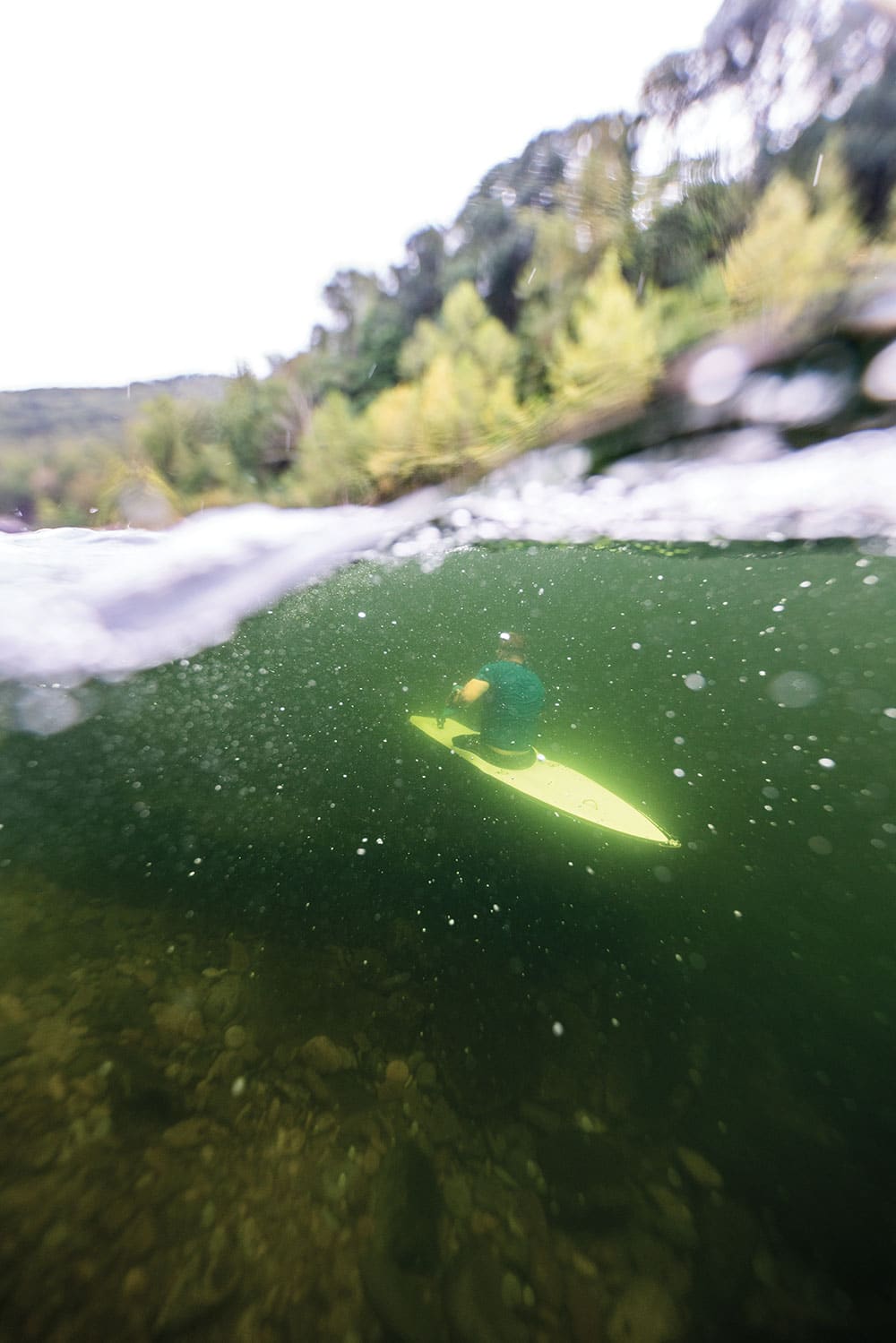
While spectators can’t really see what squirt boaters are doing from the riverbank, Gabe DeWitt dives beneath the surface to bring back photos and videos of the sport. In 2018, his film, “Charging Arc,” won the Best Short Film Award at the Paddling Film Festival. The film, featuring Jim Snyder, illustrates how squirt boaters maneuver underwater. You also see glimpses of how DeWitt gets photographs of the paddlers.
“I don’t bring any supplementary oxygen or anything down,” he said. “I hold my breath. I can do upwards of over two minutes if I’ve been doing it a bunch. That’s kind of my ace in the hole. I can stay down there longer than the boaters can. So, I get down there a good 10 to 15 seconds before they do and post up.”
DeWitt slows his heart down and takes a few preliminary breaths before diving beneath the surface. “The main trick to staying underwater is forgetting that you’re holding your breath,” he said. “The best way I’ve found to distract the conscious mind is to count prime numbers. I usually don’t start doing primes until I start getting a slight burning in the chest, which is one of the natural reactions of your body.”
Once he’s underwater, DeWitt tries to make sure he’s out of the boater’s way but also in position to get the photo.
“My biggest thing is to try to be out of the perception of the boater,” he said. “I usually like to be below them if possible. I find that to be a little easier to avoid. I look for rocks, I look for handholds. You kind of got to triangulate under there because there’s a lot of moving water that vibrates the camera like crazy.”
For DeWitt, it’s neat to capture the intimate community that has formed around such a specialized sport.
“You have X amount of people who do boating,” he said. “And then you’ve got whitewater. Then from whitewater, you have kayaking. From kayaking, you have play boating. From play boating, you then have squirt boating. So, you have this hierarchy that flows down and shows how niche of a niche of a niche of a niche of a niche this sport really is. I think that is a fascinating thing about squirt boating. It’s so weirdly particular.”
TOP PHOTO: Jim Snyder submerges his boat at Fascination Alley on the Cheat River. Photo by Gabe DeWitt
